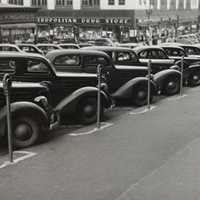Parking Policies and Quality of Urban Environment
Abstract
Several Documents of the European Union clearly show that even though mobility is a key element for urban development, mobility policies in urban areas have to be firmly re-addressed in order to mitigate the current heavy environmental costs. Up to now, the scientific debate and the several initiatives promoted by the European Union for steering urban transport towards sustainability seem to converge on one point: the overall number of cars has to be reduced and public transport has to be encouraged in order to increase the sustainability of urban mobility. In the last decade the transition towards a new culture of urban mobility, able to improve urban development and contextually increase the accessibility, the quality of life and the safeguard of natural environment has been largely promoted by European Union. Nevertheless, statistical data show that no significant reduction in the number of private cars in European countries has been achieved. Moreover, the private transport as well as the kilometres covered by car in urban areas are expected to increase. In such a context, what is the role of parking, which represents one of the key elements of an urban mobility mostly based on private car? The choices on parking matter are, in fact, a key element for reducing the dependence on private car inside the city, apart from representing an important connection between transport policies and land use policies. By regulating the supply of available parking, the use of private car can be discouraged, improving in the meanwhile alternative transport modes. In other words, the limitation of parking supply is one of the main tools to get rid of car traffic inside cities:being aware that there is no parking available at destination, people will choose alternative ways to reach it. Thus, parking is recognized on the one hand as a crucial problem, above all in the central areas of big cities, capable of strongly reducing their attractiveness; on the other hand, as the most effectively tool for limiting car use within the cities. Grounded on these assumptions, this paper explores the complex relationships among parking policies, mobility policies and policies targeted to improve urban quality. In detail, the ever-growing importance gained by the mobility policies in view of improving urban quality, as well as the persisting inconsistency between parking policies and mobility policies have been pointed out. Finally, some guidelines for re-addressing parking policies in urban areas have been provided, according to three key-requirements: a strict coherence between parking policies and mobility policies; an effective management of parking demand – especially in some urban areas and according to the parking typology – in opposition to policies of supply promotion; an increased attention to the integration between mobility policies and land uses choices, which strongly affect the parking demand.Downloads

Copyright (c) 2014 Tema. Journal of Land Use, Mobility and Environment

This work is licensed under a Creative Commons Attribution 4.0 International License.
Authors who publish in this journal agree to the following:
1. Authors retain the rights to their work and give in to the journal the right of first publication of the work simultaneously licensed under a Creative Commons License - Attribution that allows others to share the work indicating the authorship and the initial publication in this journal.
2. Authors can adhere to other agreements of non-exclusive license for the distribution of the published version of the work (ex. To deposit it in an institutional repository or to publish it in a monography), provided to indicate that the document was first published in this journal.
3. Authors can distribute their work online (ex. In institutional repositories or in their website) prior to and during the submission process, as it can lead to productive exchanges and it can increase the quotations of the published work (See The Effect of Open Access)
